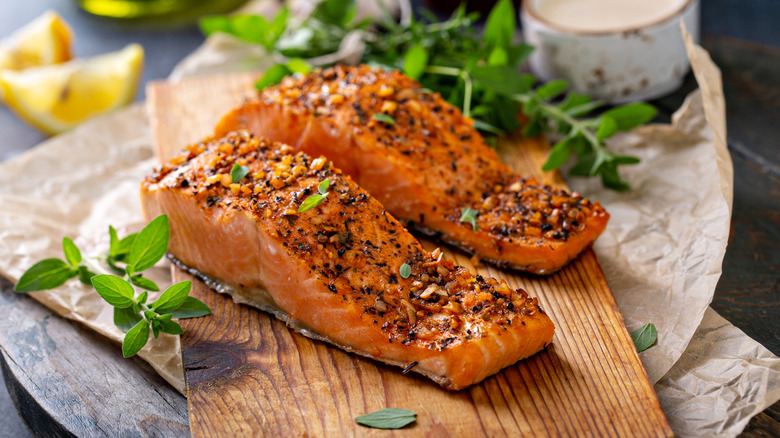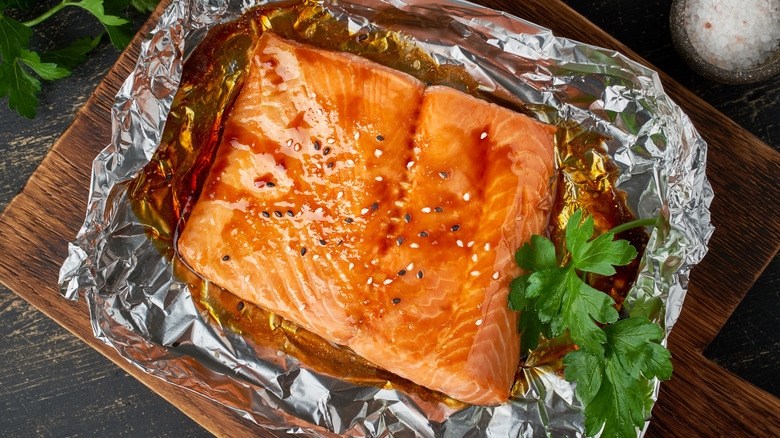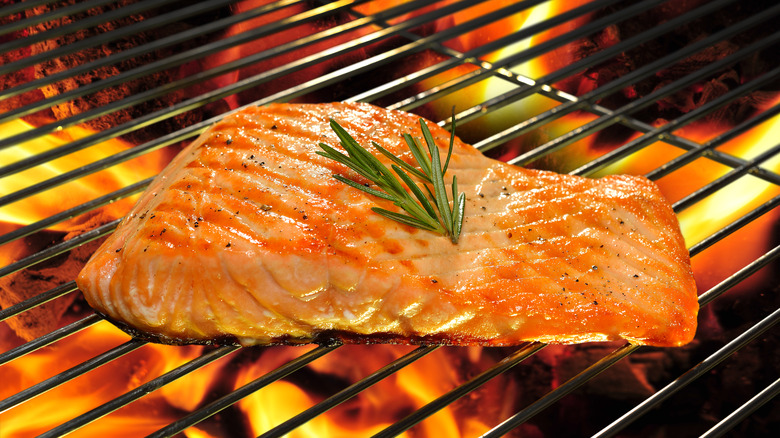How To Grill Salmon So It Doesn't Stick To The Grates
A plate of grilled salmon is something to behold, as long as it stays intact when you lift it off the grill. Cooking a steak on the grill carries its own set of challenges, but a delicate piece of fish is in a league of its own. Fish tends to stick to grill grates and can be difficult to remove cleanly. The simplest way to keep a salmon filet from shredding into cat food is to put something in between the fish and the heat, like a wooden plank.
Cedar planks are most commonly used, but other woods, such as maple and hickory, can also impart a delicious smoky taste to the fish. Before throwing it on the grill you'll want to soak the wood plank so it doesn't burn — 30 minutes of soaking is long enough. Plain water will do the job just fine, but if you want to add a depth of flavor to your grilled salmon, soaking it in cider, citrus juices, or a flavored liqueur will give the fish a personality boost when it's finished.
Once the wood is soaked, set it on the heated grill and put the salmon on the plank skin side down. The plank will protect the salmon from the flames and steam the fish while infusing it with the woody-sweet flavors. When things have reached temp, cover your grill, and in about 12 minutes, you should have a perfectly cooked and fully intact salmon filet.
Alternatives to grilling salmon on wood planks
Wood grilling planks are easy to find at most grocery stores and hardware stores, but you may not want to make an extra trip before you fire up the grill. In this case, there are a few grilling hacks you can take advantage of with things you likely have sitting around the house — like aluminum foil. For this method, set a sizable piece of double thick foil out where you will be preparing your fish for the grill. Place the salmon in the middle of the foil sheet and wrap the edges around the filet, creating a pouch. Top the salmon with lemons if desired before closing the foil pouch, leaving a little gap for steam to escape. Place the salmon on the grill and in 10 to 15 minutes the salmon should be flaky to the touch of a fork, indicating it is done.
During grilling season, you may already have another commonly overlooked vessel nearby to cook your fish in — corn husks. After you've shucked some corn, soak a few large outer husks in water. Set the husks out to dry on kitchen towels until they are just damp, then line up 5 or 6 on the counter. Place the salmon in the middle and wrap the others around. Tie the newly formed husk pouch with thin strips of husk and cook the salmon on the grill as you would with foil.
Cook salmon directly on the grill
If you must have those beautiful marks scoring the top of your salmon, there's no substitute for putting it directly on the grill grates. Double-check that they've been thoroughly cleaned from your last grill session, as any stuck-on char is certain to stick to the salmon during cooking. Then let the fish sit out for about 20 minutes until it reaches room temperature. Before grilling, rub the salmon with a light amount of oil and season with salt and pepper. Lubricate the grates of the grill with a bundle of oil-coated paper towels so that every bar is covered with no excess dripping off, or you could use potatoes to keep the salmon from sticking.
Now heat two parts of the grill – one at high temperature and one low. Simply adjust the burners with a gas grill, and with a charcoal grill, move the coals over to one side of the basin for higher heat on that side. Before throwing the salmon on, make sure you have a sturdy spatula around because flipping a piece of fish with tongs almost guarantees the fish will break apart. Sear the salmon on the hot side of the grill for 6 to 8 minutes, then carefully flip the fish and finish it on the cooler side of the grill for another 4 minutes. If everything has been properly oiled, your grilled salmon will remain intact with gorgeous grill marks as you pull it off the heat.


